Sylhet Women's Medical College
| সিলেট মহিলা মেডিকেল কলেজ | |
|
Sylhet Women's Medical College Hospital | |
| Type | Private medical school |
|---|---|
| Established | 2005 |
Academic affiliation | SUST |
| Chairman | Md. Saleh Uddin |
| Principal | Md. Rezaul Karim |
Academic staff | 118 (2014)[1] |
| Students | 500 |
| Location |
Mirboxtola, Sylhet, Bangladesh 24°53′55″N 91°52′21″E / 24.8986°N 91.8725°ECoordinates: 24°53′55″N 91°52′21″E / 24.8986°N 91.8725°E |
| Campus | Urban |
| Language | English |
| Website |
swmc |
Sylhet Women's Medical College (SWMC) (Bengali: সিলেট মহিলা মেডিকেল কলেজ) is a private medical school in Bangladesh, exclusively for female students, established in 2005. It is located in Mirboxtola, in central Sylhet. It is affiliated with Shahjalal University of Science and Technology (SUST) under the School of Medical Sciences.
It offers a five-year course of study leading to a Bachelor of Medicine, Bachelor of Surgery (MBBS) degree. A one-year internship after graduation is compulsory for all graduates. The degree is recognised by the Bangladesh Medical and Dental Council.
History
Holy Sylhet Holding Limited (HSHL) established the college in 2005, and established Sylhet Women's Medical College Hospital the following year. Instruction began in 2006, and the hospital opened in 2007.[2] HSHL intends to add a dental college and 4-year nursing college on the campus.[3]
Campus

The college is located in Mirboxtola, in central Sylhet, between the major intersections Chowhatta Point and Noya Sarak Point. There are two chief buildings on the 3 acres (1.2 ha) campus: one high-rise containing the college and another containing the associated 625-bed teaching hospital.[4]
Organization and administration
The college is affiliated with Shahjalal University of Science and Technology (SUST) under the School of Medical Sciences.[5][6] The college chairman is Md. Saleh Uddin. The principal is Md. Rezaul Karim.[7]
Academics
The college offers a five-year course of study, approved by the Bangladesh Medical and Dental Council (BMDC), leading to a Bachelor of Medicine, Bachelor of Surgery (MBBS) degree from SUST. After passing the final professional examination, there is a compulsory one-year internship. The internship is a prerequisite for obtaining registration from the BMDC to practice medicine.[5][8] In October 2014, the Ministry of Health and Family Welfare capped admission and tuition fees at private medical colleges at 1,990,000 Bangladeshi taka (US$25,750 as of 2014) total for the five-year course.[9]
The college admits only female students.[5] Admission for Bangladeshis to the MBBS programmes at all medical colleges in Bangladesh (government and private) is conducted centrally by the Directorate General of Health Services (DGHS). It administers a written multiple choice question exam simultaneously throughout the country. Candidates are admitted based primarily on their score on this test, although grades at Secondary School Certificate (SSC) and Higher Secondary School Certificate (HSC) level also play a part.[10] As of July 2014, the college is allowed to admit 90 students annually.[11]
See also
References
- ↑ "Faculty List". Sylhet Women's Medical College. Retrieved 2 September 2015.
- ↑ "Prospectus" (PDF). Sylhet Women's Medical College. 2013. pp. 6–7. Retrieved 2 September 2015.
- ↑ "HSHL". Sylhet Women's Medical College. Retrieved 2 September 2015.
- ↑ "Prospectus" (PDF). Sylhet Women's Medical College. 2013. pp. 8–9. Retrieved 2 September 2015.
- 1 2 3 "Sylhet Women's Medical College and Hospital". World Directory of Medical Schools.
- ↑ "Schools". Shahjalal University of Science & Technology. Retrieved 2 September 2015.
- ↑ "Governing Body". Sylhet Women's Medical College. Retrieved 2 September 2015.
- ↑ "List of Recognized medical and dental colleges". Bangladesh Medical & Dental Council.
- ↑ "Govt to fix maximum fees". New Age. Dhaka. 27 October 2014. Retrieved 2 September 2015.
- ↑ "Admission Procedure". Sylhet Women's Medical College. Retrieved 6 September 2015.
- ↑ "Health Bulletin 2014" (PDF). Bureau of Health Education (2nd ed.). Ministry of Health and Family Welfare. December 2014. p. 226. Retrieved 3 September 2015.
